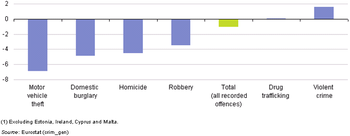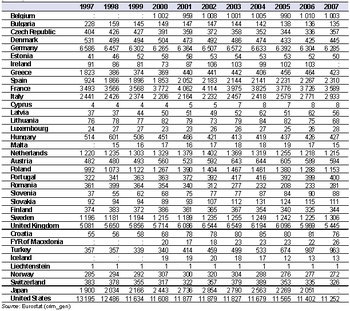Archive:Crime statistics
THIS TEXT IS IN THE PROCESS OF BEING REVISED FOR THE 2011 EDITION OF THE EUROSTAT YEARBOOK
PLEASE DO NOT MAKE ANY CHANGES UNTIL APPROVAL IS REQUESTED
- Data from September 2010, most recent data: Further Eurostat information, Main tables and Database.
Statistics that are currently available on crime and criminal justice reflect the diversity of policing and legal systems within the European Union (EU). While the development of crime and criminal justice statistics is still in its infancy, a more comparable system is in the process of being developed.
As such, comparisons of crime statistics between Member States should be based on trends over time, rather than direct comparisons of levels between countries, given that the data presented can be affected by a range of issues, including different levels of criminalisation, the efficiency of criminal justice systems, and police recording practices; it is likely that a relatively high proportion of crime remains unrecorded.
Main statistical findings
During the period between 2002 and 2007, there was a general decline in recorded crime in the EU, with the notable exceptions of drug trafficking offences (which remained almost unchanged) and violent crime (which rose, on average, by 1.6 % annually). Property offences, such as the theft of motor vehicles (down 6.8 % per year) and domestic burglary (down 4.8 % per year) declined relatively sharply during this five-year period, as did homicide (4.5 % lower per year) and robbery (3.4 % lower per year).
In a number of the Member States recorded crime figures for the period between 2002 and 2007 fell sharply; this was particularly the case in Poland, the United Kingdom, the Netherlands and France, where crime recorded by the police fell by between 12 % and 18 % over the five-year period considered; improved surveillance methods (such as closed-circuit cameras and alarm systems) are possible reasons for these changes. In other countries (such as Italy), crime appears to have risen noticeably, but in many cases the introduction of new recording methods makes it difficult to distinguish a definite trend.
Data sources and availability
National sources of information about crime show considerable differences in approach and coverage, which means that the measurement of crime trends at EU level is still at an early stage. The figures are based largely on crime figures reported by the police.
Comparisons of crime levels based on the absolute figures would be misleading, since they are affected by many factors including:
- different legal and criminal justice systems
- rates at which crimes are reported to the police and recorded by them
- differences in the point at which crime is measured (for example, report to the police, identification of suspect, etc.)
- differences in the rules by which multiple offences are counted
- differences in the list of offences that are included in the overall crime figures.
As a general rule, comparisons should be based upon trends rather than upon levels, on the assumption that the characteristics of the recording system within a country remain fairly constant over time. Where national series without definitional changes are available, general trends have been estimated.
Total crime statistics include offences against the penal (or criminal) code. Less serious crimes (misdemeanours) are generally excluded.
Context
The need to provide information on the development of crime in the EU was recognized in the Hague Programme adopted by the European Council in 2004.
The figures currently available on crime and criminal justice reflect the differing legal systems in the Member States and therefore cannot readily be compared. However, a more comparable system of crime and criminal justice statistics is being developed, as outlined in Commission communication COM/2006/437 final, ‘Developing a comprehensive and coherent EU strategy to measure crime and criminal justice: an EU action plan 2006-2010’.
Further Eurostat information
Publications
Database
- Crimes recorded by the police (crim_gen)
- Crimes recorded by the police: homicide in cities (crim_hom_city)
- Crimes recorded by the police: historical data (total crime) 1950-2000 (crim_hist)
- Police officers (crim_plce)
- Prison population (crim_pris)
- Prison population: historical data 1987-2000 (crim_pris_hist)
Dedicated section
Other information
- The Hague Programme: strengthening freedom, security and justice in the European Union (Official Journal C 53 of 3.3.2005, p.11)
- Commission Communication COM/2006/437 final: Developing a comprehensive and coherent EU strategy to measure crime and criminal justice : an EU Action Plan 2006-2010
Source data for tables and graphs (MS Excel)
External links
- Council of Europe
- Europol - European Police Office
- European Sourcebook of Crime and Criminal Justice Statistics
- Fundamental Rights Agency
- United Nations Office on Drugs and Crime - Data and analysis
See also

